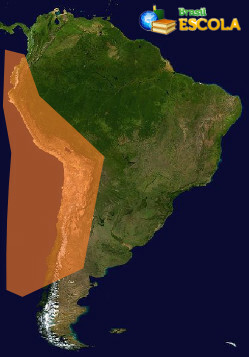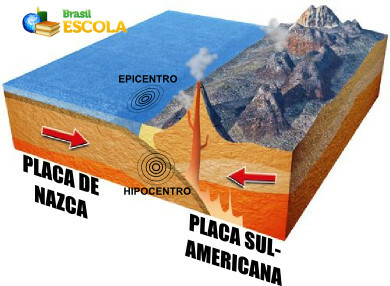Chile has been the stage for the occurrence of numerous natural disasters, especially earthquakes. And this story is not recent. In 1960, the largest earthquake ever recorded occurred in the Chilean city of Valdivia, with 9.5 on the Richter Scale, which goes from 1st to 10th. In April 2014, a new earthquake hit the country again, this time in the city of Iquique, in the northern region of the country.
But here's the big question: why are there so many earthquakes in Chile?
The explanation lies in the location of the country, which was unlucky to be located in a meeting area between two tectonic plates, the Nazca and the South American plates. These are in opposite movements, that is, they are colliding and, therefore, causing, in addition to the earthquakes, waves of volcanism and the formation of mountain ranges across the west coast of America southern.

South American geological tension zones
Earthquakes arise from the release of energy accumulated between some meeting points between two tectonic plates. With this release, the plates rearrange themselves in the lithosphere and allow for the occurrence of seismic shocks.
It works like this: when they collide, the lighter one (in this case the South American Plate) starts to “slide” over the heavier one (Nazca). However, due to the resistance of the rocks generated by the friction force at some points, the movement of the plates stops, but the force that provides the movement continues to be exerted. When this happens, it accumulates energy in this "lock-in" zone and, over time, this stored energy is so great that the resistance of the rocks is no longer sufficient to contain it, causing sudden relocation and, consequently, earthquakes.

Explanatory Schematic of the Chile Earthquake
The greater the moving force of the plates and the longer the tension time, the greater the amount of energy accumulated and, therefore, the more intense the earthquakes. In the case of the two earthquakes in April 2014, the intensity reached, respectively, 8.2º and 7.8º on the Richter Scale.
Check out the history of earthquakes in Chile below, with a list of the main cases and their intensity. In addition to these, hundreds of others of lesser intensity or with lesser consequences also occurred.
1730 – city of Valparaíso – magnitude 8.7 – number of dead not registered;
1868 – Province of Arica – magnitude 9.0 – 25 thousand dead;
1906 – City of Valparaíso – magnitude 8.2 – 3,800 dead;
1928 – City of Talca – magnitude 7.6 – 225 dead;
1939 – Commune of Chillán – magnitude 7.8 – 28 thousand dead;
1943 – cities of Illapel and Salamanca – magnitude 8.2 – 30 dead;
1960 – city of Valdivia – magnitude 9.5 – 2,000 dead;
1965 – City of La Ligua – magnitude 7.4 – 400 dead;
1985 – City of Valparaíso – magnitude 7.8 – 177 dead;
2005 – city of Tarapacá – magnitude 7.8 – 11 dead;
2010 – proximity to the city of Concepción – magnitude 8.8 – 400 dead;
2014 – City of Iquique – magnitudes 7.8 and 8.2.
By Rodolfo Alves Pena
Graduated in Geography
Source: Brazil School - https://brasilescola.uol.com.br/geografia/por-que-ha-tantos-terremotos-no-chile.htm

